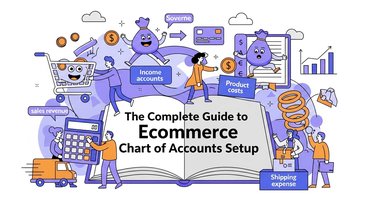Running an ecommerce business is challenging enough without the burden of manual bookkeeping eating away at your profits and productivity. Yet many online retailers continue to rely on spreadsheets, manual data entry, and time-consuming reconciliation processes that are silently draining their resources.
While the obvious costs of manual bookkeeping—like paying someone to enter data—are easy to see, the hidden expenses often go unnoticed until they've caused significant damage. From costly errors and missed opportunities to compliance issues and scalability limitations, manual bookkeeping can cost your ecommerce business far more than you realize.
In this comprehensive guide, we'll uncover the true hidden costs of manual ecommerce bookkeeping and show you how automation can transform your financial operations while delivering substantial ROI.
The Staggering Reality: What Manual Bookkeeping Really Costs
Recent industry research reveals that businesses using manual bookkeeping processes spend an average of $15,000 to $50,000 annually on hidden costs alone. For ecommerce businesses processing thousands of transactions monthly, these costs can quickly escalate to six figures.
According to studies by leading automation providers, manual invoice processing costs between $15-40 per invoice, while automated systems reduce this to just $3-5 per invoice. For a business processing 1,000 invoices monthly, this translates to potential savings of $120,000 to $420,000 annually.
The Institute of Finance & Management (IOFM) found that businesses spend an average of 16 days per year correcting manual bookkeeping errors, with each error costing approximately $53 to rectify. These statistics paint a clear picture: manual bookkeeping isn't just inefficient—it's financially devastating.
Hidden Cost #1: Labor Expenses and Opportunity Costs
The Time Drain
Manual bookkeeping consumes enormous amounts of time that could be spent on revenue-generating activities. Most ecommerce businesses estimate that manual data entry, reconciliation, and financial reporting takes 10-15 hours per week minimum.
At an average hourly rate of $30, this translates to $15,600-23,400 annually just for basic bookkeeping tasks. However, this calculation doesn't account for the opportunity cost—the revenue you could have generated if that time was spent on marketing, product development, or customer acquisition.
Scalability Limitations
As your business grows, manual processes become increasingly unsustainable. What takes 10 hours weekly for a small business can quickly become a full-time job (or multiple full-time jobs) as transaction volume increases. This means you'll need to hire additional staff or outsource bookkeeping, further increasing costs.
Seasonal Workload Fluctuations
Ecommerce businesses experience significant seasonal variations, particularly during holidays. Manual bookkeeping staff may work just a few hours weekly during slow periods but require 40+ hours during peak seasons. This inconsistency makes it difficult to:
- Plan marketing campaigns effectively
- Make strategic hiring decisions
- Meet critical deadlines for growth initiatives
- Maintain consistent financial reporting
Hidden Cost #2: Human Error and Its Cascading Effects
Error Rates and Financial Impact
Manual data entry has an error rate of approximately 1.6% per transaction. While this might seem small, the cumulative impact is substantial. For businesses processing 10,000 transactions annually, this means 160 errors that each cost an average of $53 to correct—totaling $8,480 in error correction costs alone.
Common Manual Bookkeeping Errors Include:
- Data entry mistakes (wrong amounts, dates, or accounts)
- Duplicate transaction entries
- Missed transactions or omissions
- Incorrect sales tax calculations
- Mismatched deposits and fees
- Inventory tracking discrepancies
- Revenue recognition errors
Customer Impact and Reputation DamageBookkeeping errors don't just affect your internal operations—they impact customer experience:
- Wrong inventory levels leading to overselling
- Delayed or incorrect refunds
- Billing discrepancies
- Poor customer service due to inaccurate order information
These issues result in negative reviews, lower seller ratings, and decreased customer lifetime value. For Amazon sellers, poor ratings can even lead to account suspension.
Hidden Cost #3: Compliance Risks and Audit Expenses
Sales Tax Compliance Challenges
Ecommerce businesses selling across multiple states face complex sales tax requirements. Manual processes make it nearly impossible to:
- Track tax obligations across different jurisdictions
- Calculate correct tax rates for various locations
- Maintain proper documentation for audits
- File accurate returns on time
Compliance failures can result in penalties, interest charges, and expensive audit processes. The average cost of a sales tax audit ranges from $10,000 to $50,000, not including potential penalties.
Income Tax Reporting Issues
Manual bookkeeping often leads to incomplete or inaccurate financial records, creating problems during tax season:
- Mismatched 1099-K reports from payment processors
- Inability to properly track deductible expenses
- Poor documentation for business deductions
- Extended audit processes due to disorganized records
Hidden Cost #4: Cash Flow Management Problems
Delayed Financial Reporting
Manual processes typically result in financial reports that are weeks or months behind actual business activity. This delay prevents you from:
- Making timely business decisions
- Identifying cash flow problems early
- Taking advantage of early payment discounts
- Negotiating better terms with suppliers
Missed Early Payment Discounts
Many suppliers offer 2-3% discounts for early payment. With manual processing delays, businesses frequently miss these opportunities. For a business with $500,000 in annual supplier payments, missing these discounts costs $10,000-15,000 yearly.
Poor Working Capital Management
Without real-time financial visibility, it's difficult to optimize working capital. This can lead to:
- Excess inventory tying up cash
- Inadequate cash reserves for opportunities
- Unnecessary borrowing costs
- Missed investment opportunities
Hidden Cost #5: Multi-Channel Selling Limitations
Inventory Synchronization Challenges
Selling across multiple platforms (Amazon, eBay, Shopify, etc.) with manual processes creates significant challenges:
- Inconsistent inventory levels across channels
- Overselling due to delayed updates
- Complex fee structures that are difficult to track
- Time-consuming reconciliation processes
Revenue Recognition Complexity
Each platform has different:
- Fee structures and timing
- Payment schedules and holds
- Return and refund policies
- Reporting formats and data exports
Managing these manually becomes exponentially more complex with each additional channel, often forcing businesses to limit their selling platforms and miss revenue opportunities.
Hidden Cost #6: Fraud and Security Vulnerabilities
Internal Control Weaknesses
Manual processes often lack proper controls, creating opportunities for fraud:
- Lack of segregation of duties
- Insufficient documentation trails
- Weak approval processes
- Poor oversight of financial transactions
External Fraud RisksManual systems are more vulnerable to:
- Fraudulent invoices and payments
- Identity theft and data breaches
- Cybersecurity attacks on unsecured systems
- Compliance violations leading to fines
The Klavena Solution: How Automation Eliminates Hidden Costs
Comprehensive Automation Platform
Klavena's ecommerce accounting automation platform addresses every hidden cost we've discussed:
- Automated data entry and reconciliation
- Real-time multi-channel synchronization
- Intelligent error detection and prevention
- Comprehensive compliance management
- Advanced reporting and analytics
ROI and Cost SavingsBusinesses using Klavena typically see:
- 94% reduction in bookkeeping errors
- 500+ hours saved annually per business
- 300-500% ROI within the first year
- 80% reduction in month-end closing time
- 100% accuracy in sales tax compliance
Real-World Results
Companies implementing Klavena's automation solution report:
- Cost per invoice reduced from $30 to $5
- Monthly closing time reduced from 2 weeks to 2 days
- Compliance audit costs eliminated
- Early payment discounts captured consistently
- Ability to scale across multiple channels seamlessly
Calculate Your Hidden Costs: A Simple Framework
Step 1: Labor Cost Analysis
- Hours spent weekly on manual bookkeeping: _
- Average hourly rate: $_
- Annual labor cost: _ hours × 52 weeks × $_/hour = $_
Step 2: Error Cost Assessment
- Monthly transaction volume: _
- Error rate (use 1.6%): _ × 0.016 = _
- Annual error correction cost: _ × 12 × $53 = $_
Step 3: Opportunity Cost Calculation
- Revenue per hour of focused work: $_
- Hours redirected from revenue activities: _
- Annual opportunity cost: _ × 52 × $_/hour = $_
Step 4: Compliance and Risk Costs
- Estimated audit/penalty risk: $_
- Missed discount opportunities: $_
- Fraud/security risk exposure: $_
Total Hidden Costs: $
Implementing Automation: Your Action Plan
Phase 1: Assessment (Week 1-2)
- Document current processes and pain points
- Calculate total cost of manual bookkeeping
- Identify priority areas for automation
- Set ROI targets and success metrics
Phase 2: Solution Selection (Week 3-4)
- Evaluate automation platforms like Klavena
- Request demos and trial periods
- Compare features, pricing, and support
- Check integration capabilities with existing systems
Phase 3: Implementation (Month 2-3)
- Set up automated workflows
- Migrate historical data
- Train team members on new processes
- Establish monitoring and quality controls
Phase 4: Optimization (Month 4+)
- Monitor performance metrics
- Fine-tune automated processes
- Expand automation to additional areas
- Measure and report ROI achievements
Key Features to Look for in Automation Solutions
Multi-Channel Integration
- Native connections to major ecommerce platforms
- Real-time inventory synchronization
- Automated fee and commission tracking
- Consolidated reporting across all channels
Intelligent Data Processing
- OCR and AI-powered data extraction
- Automatic categorization and coding
- Duplicate detection and prevention
- Exception handling and alerts
Compliance Management
- Automated sales tax calculations
- Multi-jurisdiction tax filing support
- Audit trail maintenance
- Regulatory reporting capabilities
Advanced Reporting
- Real-time financial dashboards
- Customizable KPI tracking
- Cash flow forecasting
- Profitability analysis by channel/product
Common Implementation Challenges and Solutions
Challenge 1: Team Resistance to Change
Solution: Involve team members in the selection process, provide comprehensive training, and highlight how automation will eliminate tedious tasks while enabling more strategic work.
Challenge 2: Data Migration Concerns
Solution: Work with experienced automation providers like Klavena who offer professional migration services and data validation processes.
Challenge 3: Integration Complexity
Solution: Choose solutions with proven integration capabilities and dedicated support teams to ensure smooth implementation.
Challenge 4: Cost Justification
Solution: Use the hidden cost calculation framework provided above to build a compelling business case showing clear ROI potential.
Measuring Success: Key Performance Indicators
Efficiency Metrics
- Time spent on bookkeeping tasks (hours/week)
- Month-end closing time (days)
- Transaction processing speed (minutes/transaction)
- Report generation time (hours to minutes)
Accuracy Metrics
- Error rate per transaction (target: <0.1%)
- Reconciliation discrepancies (target: $0)
- Compliance violations (target: 0)
- Audit findings (target: 0)
Financial Metrics
- Cost per transaction processed
- Early payment discounts captured
- Late payment penalties avoided
- Overall bookkeeping cost reduction
Business Impact Metrics
- Revenue growth enabled by freed resources
- New channel launches supported
- Strategic initiatives completed
- Customer satisfaction improvements
Future-Proofing Your Financial Operations
Scalability Considerations
Choose automation solutions that can grow with your business:
- Handle increasing transaction volumes
- Support expansion to new sales channels
- Accommodate additional entity structures
- Integrate with advanced ERP systems as needed
Technology Evolution
Stay ahead of technological advances:
- AI and machine learning capabilities
- Blockchain integration for enhanced security
- Advanced analytics and predictive insights
- Mobile accessibility and real-time updates
Regulatory Changes
Ensure your automation solution can adapt to:
- Evolving sales tax requirements
- New ecommerce regulations
- International compliance standards
- Industry-specific reporting requirements
Conclusion: The Cost of Inaction
The hidden costs of manual ecommerce bookkeeping are far more substantial than most business owners realize. From the obvious labor expenses to the subtle but significant impacts of errors, compliance issues, and missed opportunities, manual processes can drain tens of thousands of dollars annually from your business.
The research is clear: businesses that embrace bookkeeping automation see immediate and substantial returns on their investment. With error reduction rates of 94%, time savings of 500+ hours annually, and ROI rates of 300-500%, automation isn't just a nice-to-have—it's a business necessity for competitive ecommerce operations.
Klavena's comprehensive automation platform addresses every hidden cost discussed in this guide, providing ecommerce businesses with the tools they need to eliminate manual processes, reduce errors, ensure compliance, and focus on growth.
The question isn't whether you can afford to implement bookkeeping automation—it's whether you can afford not to. Every day you delay automation is another day of hidden costs accumulating, opportunities missed, and competitive advantages lost.
Take action today. Calculate your hidden costs, evaluate automation solutions like Klavena, and start your journey toward more efficient, accurate, and profitable financial operations.
Ready to eliminate the hidden costs of manual bookkeeping? Contact Klavena today for a personalized demonstration of how our automation platform can transform your ecommerce financial operations and deliver measurable ROI within 90 days.





